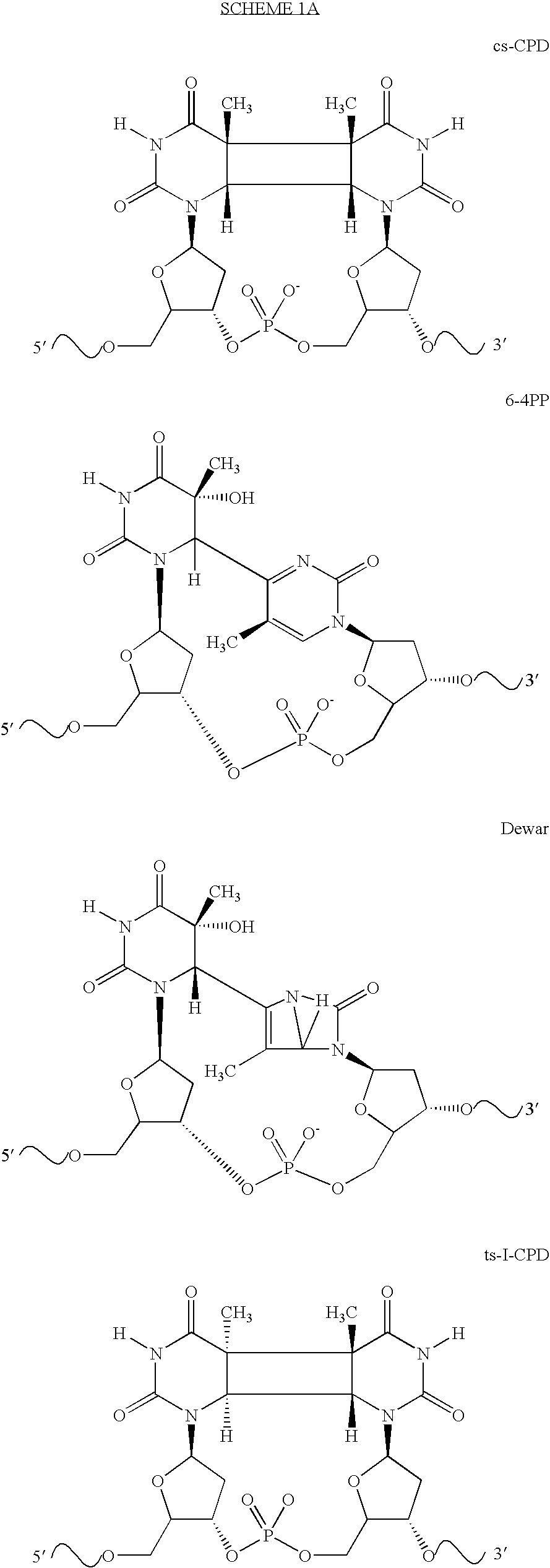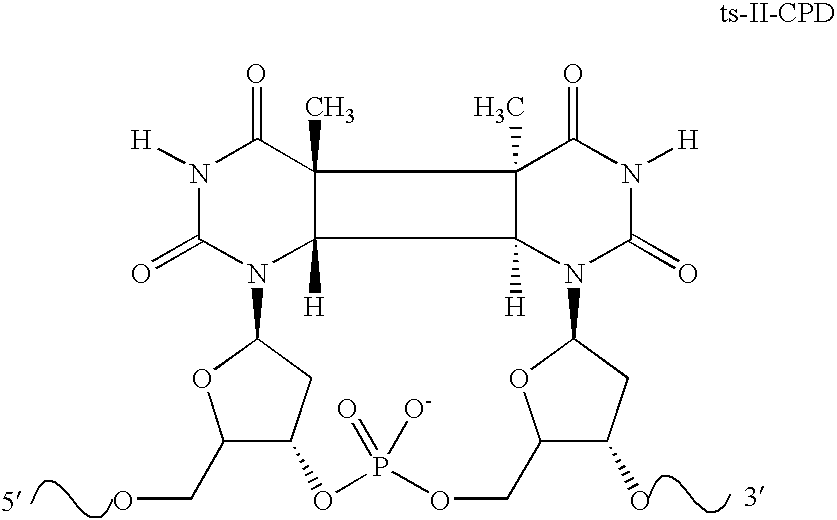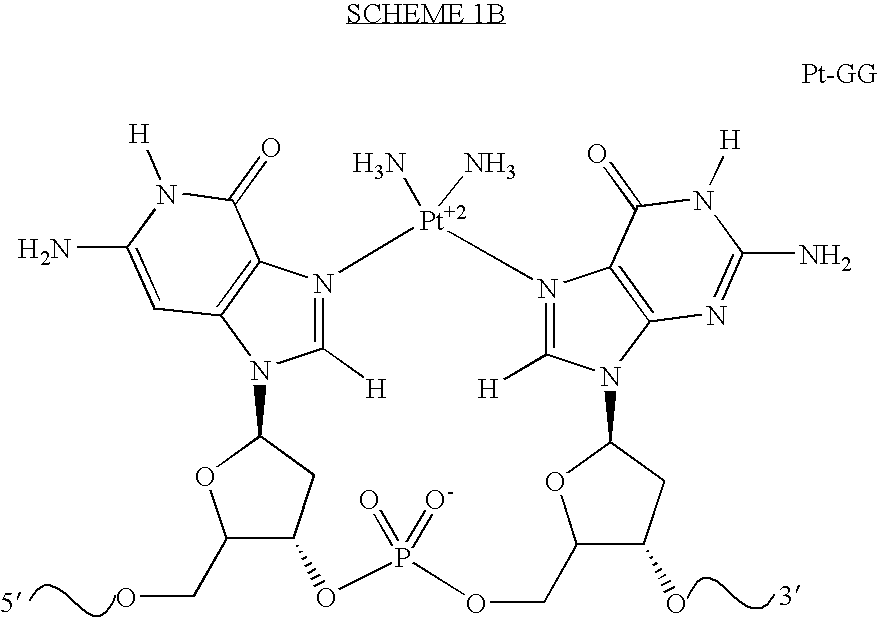Broad specificity DNA damage endonuclease
a dna damage and endonuclease technology, applied in the field of dna repair enzymes, can solve the problems of numerous detrimental effects, neoplasia or cell death, and dna is continuously subject to damage, and achieve the effect of simple assay for structural distortion
- Summary
- Abstract
- Description
- Claims
- Application Information
AI Technical Summary
Benefits of technology
Problems solved by technology
Method used
Image
Examples
example 1
Strains, Enzymes, Plasmids and Genes
[0111]E. coli Top 10 (Invitrogen Corp., San Diego, Calif.) was used for subcloning and plasmid propagation. S. cerevisiae strain DY150 used for protein expression and the S. cerevisiae expression vector pYEX4T-1 were purchased from Clontech (Palo Alto, Calif.).
[0112]S. pombe strains used in this study include 972, h−S [Leupold, U. (1970) Meth. Cell Physiol. 4:169–177]; PRS301, h−S pms1::ura4+ [Schar et al. (1993) Genetics 146:1275–1286]; SP30, h−S ade6–210 leu-32 ura4-D18 [Davey et al. (1998) Mol. Cell. Biol. 18:2721–2728]. Sp362 (h−S ade6–210 leu1–32 ura4-D18 uve1::ura4+) was constructed by transforming Sp30 with a linearized, genomic uve1+ fragment derived from pgUV2 [Davey et al. (1997) Nucl. Acids Res. 25:1005–1008] in which nucleotides 215 (EcoRI) to 1045 (ClaI) of uve1+ were replaced with the ura4+gene. Extracts of Sp362 contained no detectable Uve1p activity against CPD-30mer. Cultures were grown in pombe minimal medium (PM) [Leupold (1970)...
example 2
Amplification of the Uvde (Uve1) Gene from S. pombe.
[0114]A cDNA library purchased from ATCC was amplified by PCR, using the sense primer: 5′-TGAGGATCCAATCGTTTTCATTTTTTAATGCTTAGG-3′ (SEQ ID NO:9) and the antisense primer: 5′-GGCCATGGTTATTTTTCATCCTC-3′ (SEQ ID NO:10). The gene fragment of interest was amplified in the following manner. Four hundred nanograms of template DNA (S. pombe cDNA library) was incubated with the upstream and downstream primers (300 nM) in the presence of Pwo DNA polymerase (Boehringer Mannheim, Indianapolis, Ind.) in 10 mM Tris-HCl (pH 8.85), 25 mM KCl, 5 mM (NH4)2SO4, 2 mM MgSO4 and 200 μM of dNTPs. The DNA was initially denatured at 94° C. for 2 min. Three cycles of denaturation at 94° C. for 15 sec, annealing at 45° C. for 30 sec and primer extension at 72° C. for 2 min were followed by twenty cycles using 50° C. as the annealing temperature. All other incubation times and temperatures remained the same. The amplification was completed by a final primer e...
example 3
Amplification of the Δ228-UVDE Gene-Encoding Fragment from S. pombe.
[0115]PCR was used to produce a truncated DNA fragment of the full-length S. pombe uvde gene which encodes a protein product containing a deletion of 228aa from the N-terminal portion of the full-length S. pombe UVDE protein. The following primers were used in the PCR reaction to amplify the gene fragment which encodes Δ228-UVDE: sense primer 5′AATGGGATCCGATGATCATGCTCCACGA-3′ (SEQ ID NO:11) and the antisense primer 5′GGGATCCTTATTTTTCATCCTCTTCTAC-3′ (SEQ ID NO: 12). PCR conditions were as described in Example 2.
PUM
| Property | Measurement | Unit |
|---|---|---|
| pH | aaaaa | aaaaa |
| pH | aaaaa | aaaaa |
| temperature | aaaaa | aaaaa |
Abstract
Description
Claims
Application Information
 Login to View More
Login to View More - R&D
- Intellectual Property
- Life Sciences
- Materials
- Tech Scout
- Unparalleled Data Quality
- Higher Quality Content
- 60% Fewer Hallucinations
Browse by: Latest US Patents, China's latest patents, Technical Efficacy Thesaurus, Application Domain, Technology Topic, Popular Technical Reports.
© 2025 PatSnap. All rights reserved.Legal|Privacy policy|Modern Slavery Act Transparency Statement|Sitemap|About US| Contact US: help@patsnap.com



